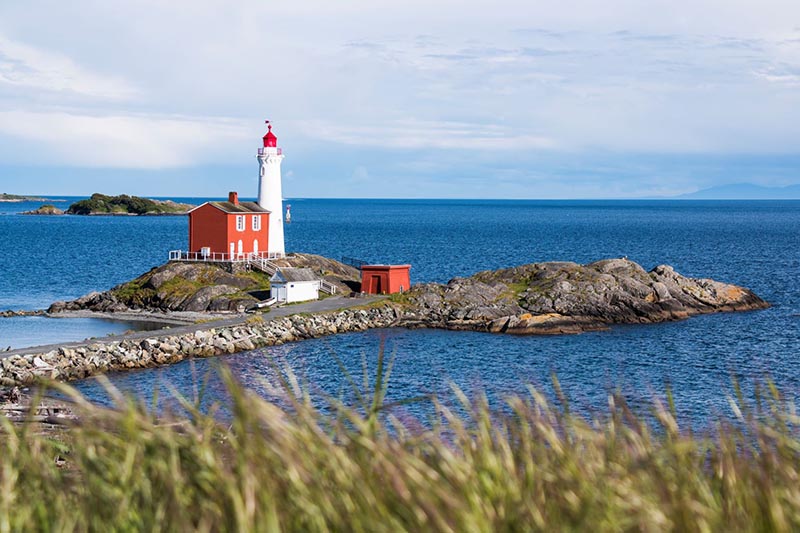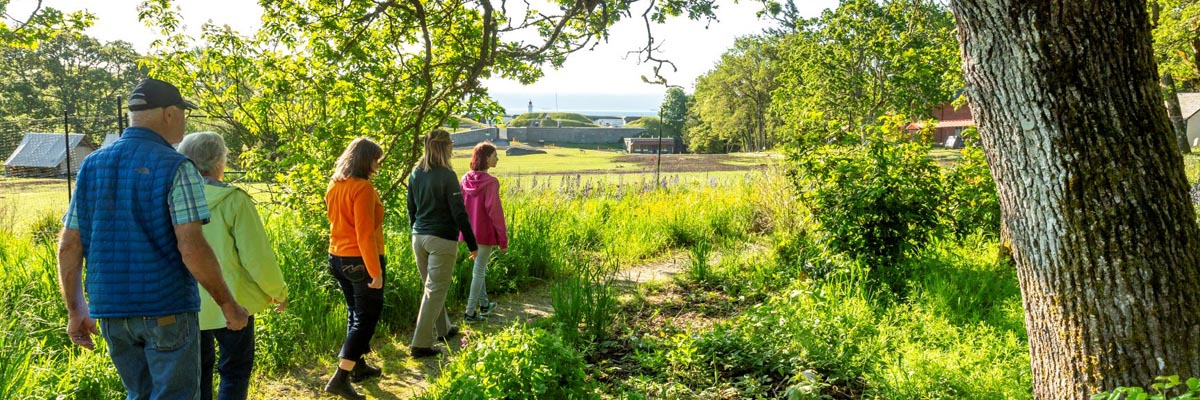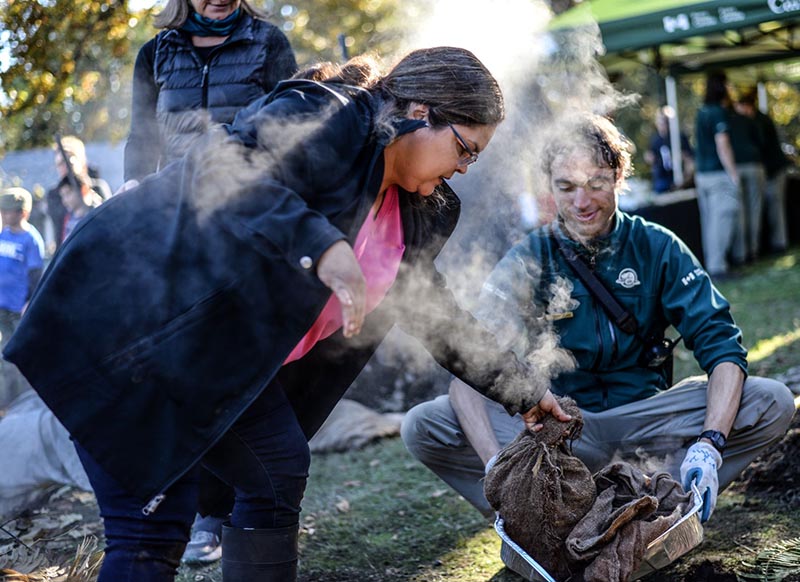What we heard — A consultation summary for the 2022 Fort Rodd Hill and Fisgard Lighthouse National Historic Sites Management Plan
Fort Rodd Hill and Fisgard Lighthouse National Historic Sites

Table of contents
Introduction
Parks Canada is preparing the management plan for Fort Rodd Hill and Fisgard Lighthouse National Historic Sites. This plan is due to be tabled in Parliament early in 2023.
A management plan, prepared in consultation with Indigenous peoples and Canadians, is the main public accountability document for heritage places administered by Parks Canada. A management plan identifies the vision and long-term strategic direction for the heritage place, and describes how that vision and direction will be achieved. It describes how the natural and cultural resources will be protected while also promoting public understanding and appreciation, and facilitating meaningful visitor experiences.
This newest management plan will replace the 2003 Fort Rodd Hill and Fisgard Lighthouse National Historic Sites of Canada Management Plan.

Engagement and consultation process
Public involvement is the cornerstone of Parks Canada’s management plans and ensures the views and vision of Canadians help shape the future of protected places. Indigenous peoples, partners, stakeholders and the public participated in the development of the management plan.
In 2018 and 2019, the initial stages of the planning process took place. This included an internal assessment, information gathering and analysis, and creating an approach to develop the management plan. At that stage, notification letters were sent to First Nations about the management planning program.
Engagement and public consultation occurred in two phases: the first phase helped develop the draft management plan, and the second phase gathered feedback on the draft document to help complete the management plan.
Phase I engagement activities
In early 2020, First Nations, key partners and stakeholders in Greater Victoria (heritage organisations, tourism industry, municipal departments and volunteer groups), were invited to participate in the first phase of consultation, and responses were received.
In-person sessions were held with partners and stakeholders to consult on elements to be considered in the draft plan. In March 2020, Parks Canada temporarily suspended consultation related to management planning in consideration of the global COVID-19 pandemic. In December 2020 Phase I consultation resumed, the management planning program was advanced and a What we heard report was completed in early 2022.
Phase II engagement activities
In spring 2022, Phase II of consultation occurred. The draft management plan was shared with First Nations, partners, stakeholders and the public. In addition to virtual engagement sessions with partners and stakeholders, the majority of public consultations took place on an online platform.

Online engagement platform
We developed an interactive online consultation and engagement platform to collect feedback on the draft management plan using a variety of engagement tools: a survey for participants to rate the draft management plan, a place to share personal stories and a place to share ideas for the future. The online platform also aimed to build awareness of the planning process and linked to key resources. The platform was open for input from March 12 to April 23, 2022.

Virtual consultation sessions
Consultation sessions with a variety of stakeholders were held in April 2022 for participants to meet with Parks Canada and discuss the draft management plan in a virtual setting. Participants were asked questions about the vision, key strategies and objectives in the draft management plan. In addition, they were asked for feedback on the management planning process, what Parks Canada was doing well and areas for improvement. All feedback was captured by a note-taker.

Consultation packages by mail and email
Some participants provided feedback by both mail and email.

Employee workshop targeting young adults
Young-adult Parks Canada employees working in the region were invited to participate in a workshop in August 2021. In this session, preliminary aspects of the draft management plan were shared and participants were asked questions about the draft vision, key strategies and objectives.
Who we heard from
Throughout the planning process and two consultation phases, Parks Canada primarily heard from community members, partners, stakeholders, and members of the public from Greater Victoria. Songhees and Esquimalt Nations, partners and stakeholders were personally invited to participate, while the public was invited through social media, media relations and other communications efforts.
Indigenous communities
Songhees Nation and Esquimalt Nation were invited to participate in both consultation phases and the draft management plan was provided for review. Parks Canada continues to work with both Nations to build on our shared goals and to explore ways to build stronger relationships. Indigenous community members were also invited to utilise the online platform.
Partners and stakeholders
Partners and stakeholders (heritage organisations, tourism industry, municipal departments and volunteer groups) participated in a total of eight in-person and virtual consultation sessions, some in the first consultation phase and some in the second. A total of 31 individuals participated.
Public and the online platform
During Phase II consultation, while the majority of online participants hailed from the Greater Victoria Region, other participants from other regions of British Columbia and Canada participated including: Vancouver Island (Duncan, Honeymoon Bay, Nanaimo, North Saanich, Parksville, Shawnigan Lake, Shirley, Sooke, Sidney), British Columbia (Vancouver, Abbottsford, and Summerland), and Ontario (Mississauga).

What we heard
Participants shared thoughtful feedback and reemphasised the importance of Fort Rodd Hill and Fisgard Lighthouse National Historic Sites and the adjacent lands to First Nations, partners and stakeholders, communities and residents, and visitors.
During Phase I consultation, participants recognised the key role the national historic sites play in fostering appreciation and understanding of the cultural and natural heritage of the area. They identified the sites as a place of connection, protection and exploration. They also shared feedback on what they feel is being done well and areas where they think improvement is needed. This feedback was used to develop the draft management plan.
During Phase II consultation, participants were encouraged to share detailed feedback on the vision, key strategies and objectives of the draft management plan:
- aspects they would like to change or add to the vision, and
- additional comments and suggestions about the three key strategies and corresponding objectives.
The following sections summarise feedback received during Phase II consultation.
Refining the vision
During Phase II, the majority of respondents supported the draft vision and when asked what aspects they would change or add to the vision, many views were shared and themes emerged. [See Figure 1: How respondents rated the draft management plan.]

Figure 1: How respondents rated the draft management plan — Text version
| Draft Management Plan Component | % Support | % Oppose |
|---|---|---|
| Vision | 87% | 8% |
| Key Strategy 1 | 89% | 6% |
| Key Strategy 2 | 89% | 8% |
| Key Strategy 3 | 90% | 8% |
Parks Canada heard different perspectives on how we share stories and educate visitors and Canadians. Respondents expressed support for increasing the scope of storytelling to include Indigenous peoples and their stories, among others, while other respondents expressed concern with the hierarchy of storytelling and that expanding the perspectives, voices and stories risks losing the original commemorative intent of the sites. Respondents asked for clarity in Parks Canada’s approach.
I think that, as a world, we're well past glamourizing war like we did in previous generations. I'd like to see the military parts of the site maintained but also put into context with the history of colonialism and Indigenous history. The nuances of a site that had such a range of significance could be a great learning opportunity. I'd also like to see school programs aligned with these critical changes over time.
While I understand there are many components of the vision, I would like to see greater focus put to the historical aspect of the park. Fort Rodd… represents the unexplored and unknown history of the British and Canadian militaries along the West Coast. I think the vision should emphasize preserving and sharing this history through more historical programs and greater use of volunteers such as the VEMRA group and veterans of the armed forces to show their passion for this subject.
We know that many different peoples lived for millennia in every region of what became Canada. Participants expressed the desire to understand the stories of Indigenous peoples and to confront the difficult aspects of colonialism, its impact on Indigenous peoples and the inter-relationship between these peoples and Canada’s military. Alongside and separate to this feedback includes calls for Parks Canada to work closely with First Nations to increase their onsite presence, decision-making influence and inclusion in the storytelling approach.
More acknowledgment of the First Nations people, their relationship with the military, and their story on this particular site prior to and during growing colonial contact.
The protection of rare ecosystems is important to some respondents, as is the stewardship and respect for the sites and adjacent lands as First Nations territories. Participants acknowledged the work Parks Canada does to protect and present species at risk and also signalled work yet to be undertaken given the variety of opportunities to collaborate throughout the region.
More and better identification of endemic and indigenous species on the site, particularly species at risk, their importance and the importance and methods of conservation.
We heard that Parks Canada should improve accessibility and that this vision reflects greater focus on increasing and diversifying how people can experience the sites. In addition, some respondents asked Parks Canada to be more transparent and identify ways in which the sites are currently accessible for new and returning visitors.
I might expand the idea/section about a vision of how less abled people can access the park. A bit more detail even in the vision part of a plan draws in those of us who are less abled.
Feedback on the key strategies and objectives
During Phase II, the majority of respondents supported the proposed key strategies and objectives and when asked if they felt they are important to the future of the sites, many views were shared and themes emerged. [See Figure 1: How respondents rated the draft management plan.]
Share the larger story
The majority of respondents expressed interest in the sharing of stories from the time prior to when the fortifications and lighthouse were built. They encourage Parks Canada not to shy away from telling more difficult stories. Acknowledging the impacts of colonialism on Indigenous peoples is an important part of the stories and places in Canada.
Emphasis on military history
A handful of respondents expressed the desire to ensure the emphasis of military history is maintained and pivotal in the hierarchy of stories presented onsite. Some respondents also expressed the value of re-enactments, demonstrations and activities delivered by third parties and volunteers that enhance the onsite experience, especially for locals with visiting friends and relatives.
Importance of conservation efforts
Organisations such as Parks Canada play a key leadership role in conservation efforts, both cultural and natural, and many respondents emphasised this important work. The role of First Nations communities and other organisations, and the importance of working to tackle issues together, is prominent. The value of this collaborative work extends to education efforts, such as the learning meadow, and the responsibility of restoration efforts for the Garry Oak ecosystem.
Importance of collaborations
Collaboration and working with a variety of organisations and external parties is important to a large number of respondents. This includes working with diverse groups to achieve a variety of goals. Working with First Nations dominated this feedback. In addition, the desire for aligning efforts with local and regional organisations to implement events, programs and activities is prevalent.
Consider sustainability of increased visitation
Many respondents posed questions about the sustainability of increased visitation. In some cases, this included comments about adapting to new audiences and their changing needs with an interest in improving accessibility.
Operations
Parks Canada also received many comments on current operations including hours of operation and seasonality, facility conditions, and programming, among others. These comments were compiled and shared with the Visitor Experience and Site Manager at Fort Rodd Hill and Fisgard Lighthouse National Historic Sites to be considered in operational planning.
Meaningful connections
Alongside rating the draft management plan, participants were also prompted with a handful of questions to generate ideas and share stories.
All feedback was carefully reviewed and considered to finalise the 2022 Fort Rodd Hill and Fisgard Lighthouse National Historic Sites Management Plan. Many thanks to all who participated. The feedback will help shape the management of Fort Rodd Hill and Fisgard Lighthouse National Historic Sites.
While carefully reviewed and considered, not all suggestions and concerns were incorporated into the final management plan. Some comments have directly influenced the management plan, and others have been flagged for further consideration during the implementation of the plan over the next ten years. It is important to consider the Parks Canada Agency’s priorities in the development of the 2022 management plan:
- Fort Rodd Hill and Fisgard Lighthouse National Historic Sites are within the homelands of the Songhees and Esquimalt Nations, and the lands and waters around Fort Rodd Hill and Fisgard Lighthouse are ecologically, culturally and spiritually important places for these people. Acknowledging the impacts of colonialism on Indigenous peoples and their connection to traditionally used lands is an important part of healing trauma and taking a step toward reconciliation.
- The management plan will consider all of the sites’ values and opportunities in addition to the initial reasons for designation as national historic sites. Sharing these layered and interrelated themes at Fort Rodd Hill and Fisgard Lighthouse is guided by Parks Canada’s system plan for national historic sites, a Framework for History and Commemoration. This framework outlines a more inclusive, accessible and engaging approach to Canada’s history. Extending the stories that are told at heritage places, beyond their original commemorative intent for designation, allows for more narratives, perspectives and voices to be heard.

- To deliver diverse experiences and protect heritage resources, the roles of partners and stakeholders are vital. As lands and waters that are culturally significant to First Nations, increasing the level of collaboration with Songhees and Esquimalt Nations is particularly important to Parks Canada. Parks Canada also works closely with conservation, history and tourism partners in the Greater Victoria Region, and dedicated volunteers make a significant contribution at Fort Rodd Hill and Fisgard Lighthouse.
What’s next…
The planning team for Fort Rodd Hill and Fisgard Lighthouse National Historic Sites will complete the 2022 management plan and, once tabled in Parliament, will be released to the public. For updates on the management planning process, check our website regularly and sign up for our e-newsletter.
Contact us
Fort Rodd Hill and Fisgard Lighthouse National Historic Sites
603 Fort Rodd Hill Road
Victoria, British Columbia, V9C 2W8
Fort Rodd Hill and Fisgard Lighthouse National Historic Sites
- Date modified :